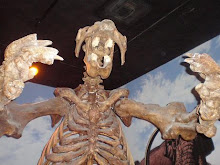 In many ways, the idea of a Matanzas Pass Preserve is a little ironic, as I came to learn from a brief history lesson that I received while at the natural habitat. Recently I was officially registered with FGCU as a Spanish minor. I have quite an affinity for the language and Latin culture. Thus it interested me much to learn that "matanzas" is Spanish for "massacre," which I was actually unaware of before the field trip. I would like to comment on the irony inherent in the fact that an area of land named after the massacre of Native Americans - and hence the non-preservation of livings organisms - is now being used to preserve life. It's definitely a good thing, but something to think about.
In many ways, the idea of a Matanzas Pass Preserve is a little ironic, as I came to learn from a brief history lesson that I received while at the natural habitat. Recently I was officially registered with FGCU as a Spanish minor. I have quite an affinity for the language and Latin culture. Thus it interested me much to learn that "matanzas" is Spanish for "massacre," which I was actually unaware of before the field trip. I would like to comment on the irony inherent in the fact that an area of land named after the massacre of Native Americans - and hence the non-preservation of livings organisms - is now being used to preserve life. It's definitely a good thing, but something to think about.Anyway, the trip began with the aforementioned history debriefing at the Estero Bay Historic Cottage, which is a structure remaining from the inhabitants of Ft. Myers Beach that lived during the early 20th century. For some reason it was surprising to me to learn that there were non-natives living on the island of Ft. Myers Beach at that time, but it makes sense. According to the woman in charge of the cottage, things were very simple back then. Most of the people living on the island fished and the environment was thriving. The woman in charge of the cottage also described an arch that formed the entryway from Ft. Myers to Ft. Myers Beach, when the bridge connecting them was first built. This edifice no longer stands, but it sounded as though it was a tourist attraction. Things have changed regarding the ecosystem as well, as chemicals being leeched into the waters have changed the water composition and killed a large portion of the sea life. The information that the woman at the Estero Bay Historic Cottage gave was relatively interesting and I would not have learned them otherwise, I'm sure, but I think that most of my classmates would agree with me that it was not the best part of the trip.
After sitting around in the small cottage it was time to head into the Matanzas Pass Preserve, where no doubt, Spanish soldiers were waiting to do battle. If only that were the case, but I digress. Indeed it would prove to be just about as interesting, as the Matanzas Pass Preserve is a unique mangrove forest ecosystem.

The above photo showcases the unusual tangle of roots that are peculiar to the red mangrove, which is the most common mangrove. There are three types of mangroves, the red, black, and white, however they are not related plant species. In the following photograph, there is a comparison of the black (left) and red (right) mangroves.
 Whereas the red mangrove leaves are shiny and vibrant green, the black mangrove leaves have almost a powdery appearance. Further investigation at the "Black Mangrove" entry on Wikipedia.org (http://en.wikipedia.org/wiki/Black_mangrove) will tell you that the whiteness of the leaves is a result of salt that is secreted at night.
Whereas the red mangrove leaves are shiny and vibrant green, the black mangrove leaves have almost a powdery appearance. Further investigation at the "Black Mangrove" entry on Wikipedia.org (http://en.wikipedia.org/wiki/Black_mangrove) will tell you that the whiteness of the leaves is a result of salt that is secreted at night.Other trees that are in high concentrations in Matanzas include this saw palmetto, which I am told has edible leaves.

...As well as this example of a redemption fern, which actually grows on the limbs of other trees. I have been aware for quite some time that ferns are very ancient forms of plant life with simple photosynthetic systems.

About mid-way through the preserve, the class stopped to take in the beauty of Estero Bay, which, at least in the area of the preserve, is a little safer from environmental massacring.

Of course, these photographs do not reveal everything present in the mangrove swamp of Matanzas Pass. There were many small crabs crawling along the trees, but they were very fast and tended to sit right on the side of the tree where it was hardest to take a picture of them! And of course there was the snake at the beginning of this post that a classmate and I encountered. It seemed frozen in place. I would imagine that in general it is difficult to get that close to a snake in the wild, and at least in my opinion, they are worth saving. There were also cypress trees and some scattered palms.
The field trip proved to be very relaxing and surprising. From ironic Spanish expressions to bizarre wildlife, the Matanzas Pass Preserve is my kind of natural habitat.

No comments:
Post a Comment